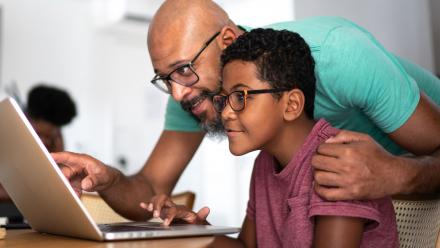Multilingual families are valuable partners in their child's education, but their expertise and contributions may be overlooked, especially at the secondary level. The following articles offer ideas on how to connect and communicate with the multilingual families for English language learners (ELLs) in middle and high school.
You can learn more about teaching this age group from the other articles in this series:
Family partnership strategies
Look for ways to make families feel welcome within the school community.
Making families feel welcome is a first step in building trust and establishing a connection. Many families may be hesitant to come to the school because families may have a different role in their child's education in their home country; they also may be concerned about being asked about their immigration status or ability to converse in English.
You can welcome families by:
- regularly expressing that all families are welcome
- posting welcome signs and messages of support on doors in multiple languages
- displaying items that reflect families' cultures and countries, such as flags, artwork, or students' own work
- inviting them to share their students' strengths, talents, and interests
- asking them to share their questions and concerns
- encouraging them to take on leadership roles.
Note: School staff should never ask any family member or student any questions related to their immigration status. All students have a legal right to attend K-12 public schools in the U.S. regardless of immigration status. To learn more about how schools can support immigrant families, see our related in-depth guide.
Ensure families have access to information in their home language.
All families are legally entitled to information in their home language. Find out what language resources you have available (interpreters, a language line, etc). If you are unsure of how to provide families with language access, talk with the ELL or bilingual department in your district about resources available to multilingual families. In addition, you can talk with an ESL colleague or administrator about increasing families' language access if needed.
For additional ideas, see:
Identify the best ways to communicate with ELL families
In order to connect and communicate with ELL families, try the following:
- Find out how families prefer to communicate and look for ways to use the tools they feel comfortable with if possible, such as WhatsApp. You may also wish to try the Talking Points translation app.
- Ensure that you help multilingual families keep their contact information updated, even if it changes frequently.
- Try to learn more about families' schedules. Keep in mind that families may work different shifts and may not be available (or allowed) to answer calls or texts when they come in.
- Remember that immigrant families often have strong networks among themselves — look for ways to harness that power!
- If you are having trouble connecting with a family, try reaching out to some other colleagues who may be able to help, like a family liaison, another teacher who has taught the student, a coach who knows the student, or an administrator who may be able to offer key support.
You can learn more from the following:
Partnering with families in the service industry
Include ELL families in any college or career outreach
The process of navigating college applications and financial aid is challenging for English-speaking families, even if they have some experience with college. It’s even more daunting for first-generation students who may be trying to figure out the information in another language. You can include ELLs and their families in your college and career outreach by:
- ensuring that ELLs and their families are invited to information sessions, field trips, or events and know what the purpose of the events are
- making information available in families’ languages
- having interpreters available who can answer questions
- highlighting stories of first-generation students from your community who have gone on to college.
See more ideas in the following article:
Partner with the schools that students’ younger siblings attend
Many ELL students have extensive responsibilities at home, including the care for younger siblings. Schools that serve the same families can partner together through tutoring, reading buddies, or mentoring programs, or less formally through activities that include entire families.
For example, Salina Intermediate School in Dearborn, MI works closely with its sister school, Salina Elementary School, to coordinate community events and activities. The elementary staff also know that older siblings can be an important source of support. When the elementary school started a virtual summer program after the COVID-19 pandemic began, they enlisted older siblings as a point person on technology at home and to ensure that younger siblings logged on to their class at the right time. (In this case, the schools are close to each other, but schools don’t need to be geographically close to work together.)
Partner with community organizations
As you get to know your students and families better, you will identify key areas of interest or areas where extra support would be helpful. Consider which kinds of partners make the most sense for your students and families based on their input, questions, and concerns. See more ideas in the following:
Featured videos
You Are Welcome Here: Supporting the Social and Emotional Health of Newcomer Immigrants
How school leaders can respond to anti-Asian bullying and violence
Principal Victor Tam urges school leaders to consider how the rise in anti-AAPI violence during COVID-19 impacts their students and families — and how to respond as a leader in the community.
